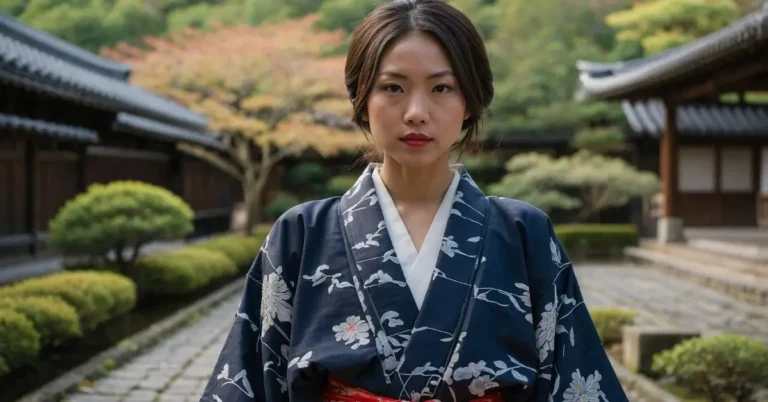Historical Origins of the Haori
The haori traces its origins back to the late Sengoku (Warring States) period (1467-1603), when it was worn primarily by the samurai as a protective overgarment. Originally, it served a functional purpose, providing warmth during colder weather and offering protection from rain and wind while riding horses. Unlike the full-length kimono, the haori was shorter and worn open in the front, making it easy for warriors to move freely during battle.
During the Edo period (1603-1868), Japan experienced prolonged peace under the Tokugawa shogunate, and the haori gradually shifted from being a utilitarian garment to one with more symbolic and cultural value. Samurai began wearing more ornate versions of the haori over their armor, showcasing their family crests or mon. Over time, the haori’s aesthetic appeal spread beyond the warrior class, becoming popular among merchants and townspeople. As social restrictions around clothing loosened, commoners began to adopt the haori for everyday use, incorporating it into their own clothing practices.
Cultural Significance of the Haori
The haori has long been a reflection of Japan’s rich cultural traditions. Unlike the kimono, which is often associated with formal ceremonies and specific rituals, the haori is worn more casually, providing both functionality and style. It has historically symbolized status, taste, and personal identity in various ways.
The association of the haori with the samurai class imbued it with connotations of discipline, respect, and loyalty. The samurai’s haori often bore their family crest, which was a visible representation of their lineage and allegiance to their lord. In the Edo period, the intricate designs of the haori’s lining became a subtle way for wearers to express individuality and personal style. These inner linings often featured beautiful patterns, embroidery, and even paintings that could only be seen when the haori was removed, adding an element of mystery and intrigue to the garment.
In modern times, the haori has transcended its class-based origins and become a cultural icon. It is often worn during festivals and celebrations like the Japanese New Year, tea ceremonies, and other traditional events. The garment’s continued popularity is a testament to its cultural resonance, representing the harmony between Japan’s historical past and its evolving fashion sensibilities.
Haori for Men and Women
Traditionally, haoris were worn primarily by men, especially during the Edo period, when strict clothing regulations dictated how men and women could dress. The haori worn by men tended to be simpler in design, often featuring solid colors or muted patterns, with family crests embroidered on the back.
However, by the late 19th and early 20th centuries, women began wearing haori as well. This change coincided with Japan’s Meiji Restoration (1868-1912), which ushered in rapid modernization and Western influence. Women’s haori became more colorful and elaborate, often featuring intricate floral motifs and bold, vibrant patterns. Unlike the men’s haori, which was typically worn over a hakama (traditional trousers), women’s haori was draped over a kimono, adding an extra layer of beauty and elegance to the ensemble.
In contemporary Japan, both men and women wear haori for various occasions. Women’s haoris are now commonly worn as part of formal and semi-formal attire, particularly during weddings, graduation ceremonies, and tea ceremonies. Men, on the other hand, may don a haori for more formal settings, often pairing it with a traditional kimono during festivals or special occasions.
Craftsmanship of the Haori
The craftsmanship of the haori is deeply rooted in traditional Japanese textile art. Haoris are typically made from silk, but other materials like cotton and wool are also used, depending on the season and the intended purpose of the garment. The fabric is often hand-dyed using the traditional yuzen or shibori techniques, both of which produce stunningly intricate patterns and vibrant colors.
Yuzen is a technique that involves freehand drawing on fabric with a rice-paste resist before dyeing. This method allows for precise, detailed patterns, often featuring motifs from nature such as flowers, birds, or landscapes. Shibori, on the other hand, is a resist-dyeing technique that involves folding, twisting, or tying the fabric before applying dye, resulting in a variety of tie-dye-like patterns.
In addition to the fabric itself, the construction of the haori is an art form. Traditional haoris are meticulously sewn by hand, ensuring that the patterns align perfectly and the garment drapes beautifully when worn. The inner lining of the haori is often just as ornate as the outer layer, featuring delicate embroidery or hidden motifs that can only be seen when the garment is opened.
Modern Adaptations of the Haori
In recent decades, the haori has experienced a resurgence in popularity, both in Japan and abroad. As global interest in Japanese culture and fashion has grown, the haori has been embraced by fashion designers and enthusiasts around the world. Its loose, flowing silhouette and versatile style make it an ideal piece for layering, lending itself well to modern, casual fashion.
Japanese fashion designers have reinterpreted the haori for contemporary audiences, incorporating it into streetwear, high fashion, and even pop culture. Modern haoris are often shorter than traditional ones and are made from a wider variety of fabrics, including denim, polyester, and even synthetic blends. These adaptations have made the haori more accessible and wearable for everyday use, while still retaining the garment’s distinct cultural heritage.
Western designers have also drawn inspiration from the haori, incorporating its minimalist elegance and structured form into collections that blend East and West. The haori’s influence can be seen in modern-day kimonos, robes, and outerwear, often featuring traditional Japanese motifs and patterns.
The Haori in Global Fashion
The haori’s influence on global fashion is undeniable. It has been embraced not only for its aesthetic appeal but also for its versatility. Unlike the kimono, which is often seen as a formal garment, the haori can be worn casually or dressed up, making it a perfect fusion of tradition and modernity.
In the fashion world, the haori has made appearances on runways and in collections by designers who are drawn to its timeless design. Haute couture houses and streetwear brands alike have incorporated elements of the haori into their designs, demonstrating its adaptability across different fashion cultures.
Additionally, the haori has gained popularity in the world of cosplay and contemporary Japanese pop culture. Fans of anime, manga, and Japanese historical dramas often incorporate haori into their costumes, celebrating the garment’s historical roots while reimagining it in a fantastical or futuristic context.
How to Wear a Haori
Wearing a haori is relatively simple compared to more intricate Japanese garments like the kimono. Traditionally, it is worn over a kimono or yukata, but modern fashion allows for more freedom in styling the haori. Here are a few ways to incorporate a haori into both traditional and modern outfits:
- Traditional Style: For a more traditional look, the haori is worn over a kimono, with the haori himo (a decorative cord) tied in front to keep the garment in place. The haori should fall just above the knees, and its sleeves should be wide and flowing, allowing for ease of movement.
- Casual Look: To integrate a haori into casual wear, it can be worn over a T-shirt or blouse and paired with jeans or trousers. This creates a relaxed yet stylish look, perfect for everyday wear. Modern haoris, which are often shorter, work particularly well in casual outfits.
- Layering: The haori’s loose fit makes it an excellent layering piece. It can be worn over a dress, tunic, or even a jacket, adding an extra dimension to your outfit. Layering a haori over Western clothing creates a unique fusion of Eastern and Western styles.
- Statement Piece: Because of the beautiful patterns and colors often found on haoris, they can serve as a statement piece in any outfit. A brightly colored or intricately patterned haori can be worn over a simple, monochromatic ensemble to let the garment stand out.
Conclusion
The haori is much more than just a piece of clothing. It is a cultural artifact that reflects Japan’s rich history, evolving fashion trends, and unique craftsmanship. From its origins as a functional garment worn by samurai to its current status as a fashionable and versatile item, the haori continues to captivate both traditionalists and modern fashion enthusiasts alike. As global interest in Japanese fashion grows, the haori remains a symbol of elegance, simplicity, and timeless design.











